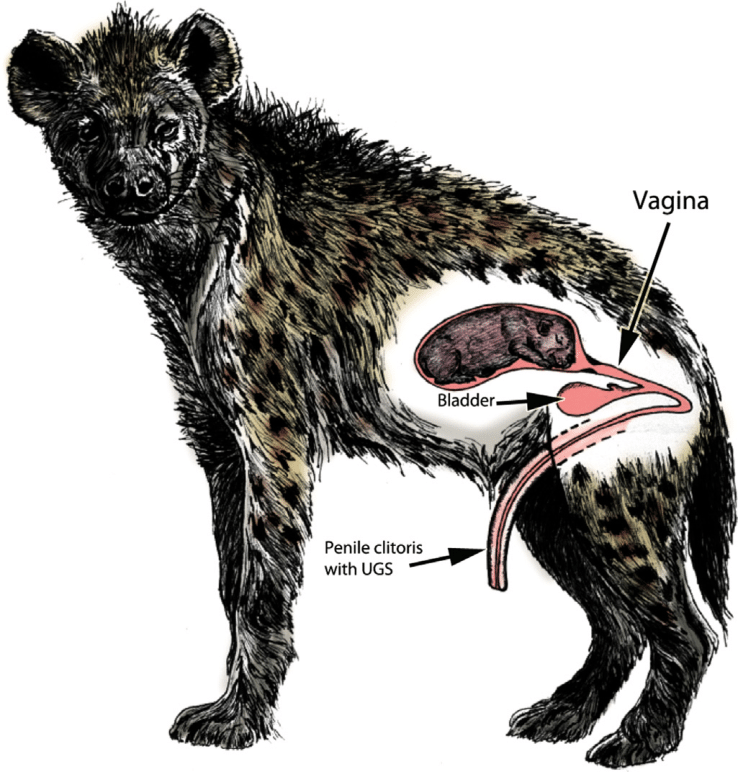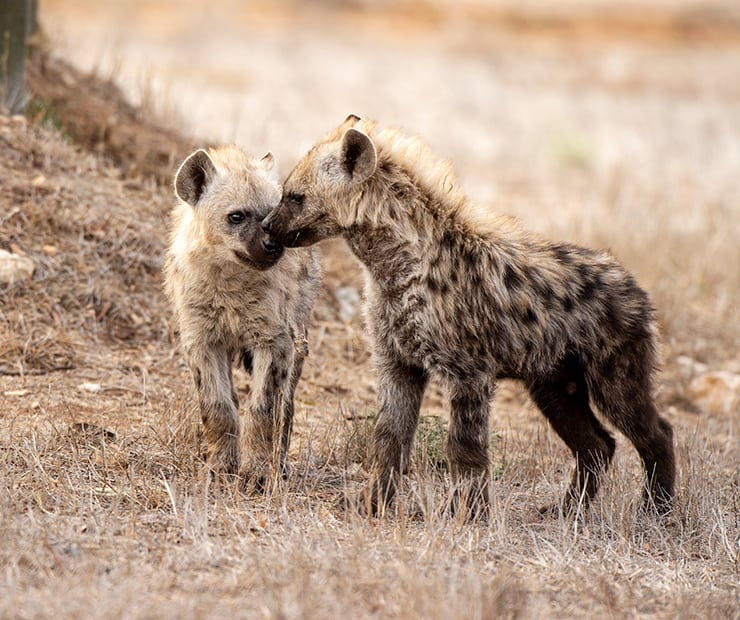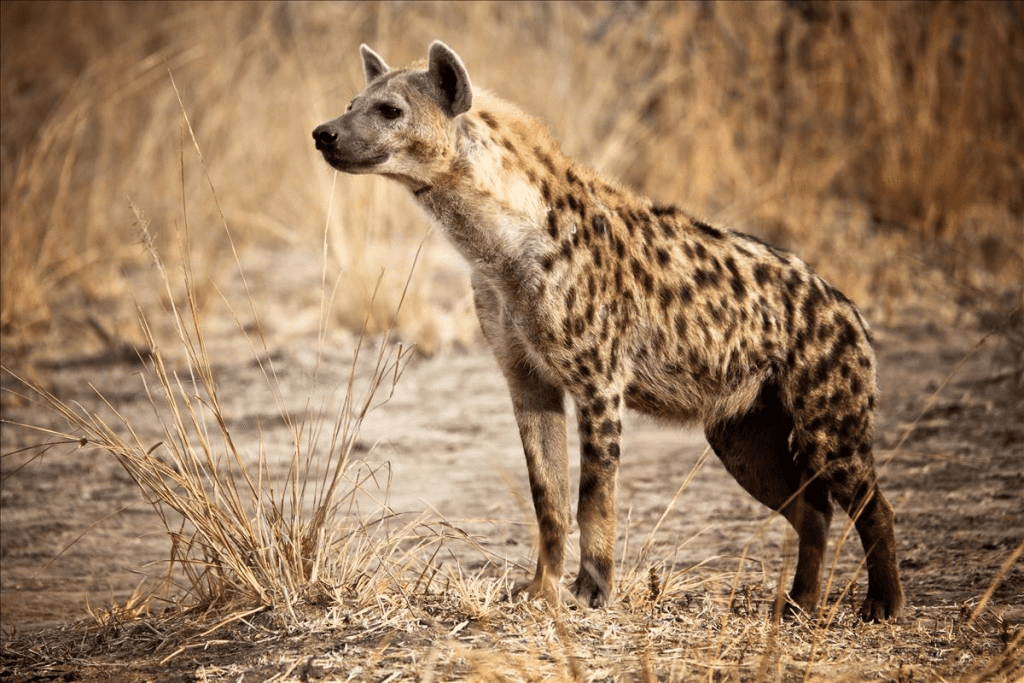Nature is full of fascinating and sometimes brutal adaptations, but few are as shocking as the birthing process of the spotted hyena. You might think childbirth is a universally painful experience, but hyenas take it to an entirely new level.
Female hyenas have one of the most unusual reproductive anatomies in the animal kingdom—what appears to be a penis is actually an elongated clitoris, known as a pseudo-penis. This rare adaptation makes mating, birth, and survival incredibly difficult for both mother and cubs.
Let’s dive into the science, struggles, and evolutionary mysteries behind why hyenas experience one of the most challenging births in the wild.
Hyenas’ Unique Reproductive Anatomy: A Bizarre Evolutionary Twist

The female spotted hyena (Crocuta crocuta) is unlike any other mammal when it comes to reproduction. Unlike most female mammals, hyenas have no external vaginal opening. Instead, their labia are fused together, forming a pseudo-scrotum, and their clitoris is elongated into what resembles a fully functional penis.
This means that both mating and giving birth happen through a narrow, tough, and inflexible canal—a structure that poses serious risks to both mother and cubs.
But why would evolution favor such an extreme adaptation? The answer lies in hyena social structure and dominance.
The Link Between Dominance and Reproductive Anatomy
Hyenas live in strict matriarchal societies, where females outrank males in dominance. The unusual reproductive anatomy is believed to be an evolutionary adaptation linked to social hierarchy.
- A Display of Strength: A larger pseudo-penis might act as a dominance signal, making it clear which females hold power in the clan.
- Hormonal Influence: Female hyenas have higher testosterone levels than males, leading to increased aggression and dominance over the pack.
- Mating Challenges: Males must earn the right to mate, as females control copulation with their complicated anatomy.
Video : Hyenas’ Brutal Birth: The Most Painful Labor in the Animal Kingdom
While this system gives females power, it comes at a terrible cost when it’s time to give birth.
Why Giving Birth Is So Dangerous for Hyenas
Imagine trying to push a newborn through a passage too small, too rigid, and highly prone to tearing. That’s exactly what female hyenas go through every time they give birth.
Here’s what makes hyena birth so deadly:
- A Super Tight Birth Canal
- The pseudo-penis acts as the only birth canal, but it is long, narrow, and lacks the elasticity of a normal vagina.
- This makes labor extremely difficult and painful, with a high chance of the tissue tearing.
- First-Time Mothers Face the Worst Risks
- Many first-time mothers do not survive the birthing process due to severe ruptures.
- Those who do survive often suffer from long-term damage to their reproductive organs.
- High Cub Mortality Rate
- A staggering 60% of hyena cubs suffocate before they are fully delivered.
- Since the birth canal is so tight, cubs often become trapped and die before they can emerge.
- A Painful Recovery Process
- After birth, the pseudo-penis often ruptures completely, forcing it to heal over time.
- Mothers suffer weeks of pain and vulnerability while their bodies recover.
Despite these brutal challenges, hyenas continue to thrive, and their unique reproductive system has remained largely unchanged for millions of years.
How Do Hyenas Mate? The Struggles of Reproduction

If you think birth is difficult for hyenas, mating is no easier. Males must overcome significant anatomical and social obstacles just to reproduce.
- Males Are Submissive to Females
- Unlike in many species where males dominate, male hyenas are the weaker sex in both power and ranking.
- They must approach females cautiously, often displaying submissive behavior to gain approval.
- Navigating the Pseudo-Penis
- Since females have no traditional vaginal opening, males must carefully maneuver through the pseudo-penis to copulate successfully.
- This requires both patience and precise positioning, making it one of the most complex mating processes in the animal world.
- Only the Strongest Males Get to Reproduce
- Males don’t fight each other for dominance like in other species. Instead, they must earn the female’s trust over time.
- Females choose mates based on persistence, patience, and respect, ensuring only the most determined males pass on their genes.

Given how dangerous and inefficient the reproductive process is for hyenas, one might wonder why evolution hasn’t corrected this issue.
The answer lies in survival strategy and social dynamics.
- Matriarchal Control Guarantees Stronger Cubs
- By limiting mating to only the most persistent males, female hyenas ensure that their cubs inherit strong genetics.
- This method prevents weaker genes from spreading, keeping the species robust.
- Higher Testosterone Helps With Survival
- The same high testosterone that makes birth difficult also makes female hyenas stronger and more aggressive.
- This aggression helps protect their cubs and maintain dominance in their environment.
- Fewer Cubs = More Resources
- Since many cubs don’t survive birth, the ones that do are often given more attention and resources.
- This ensures the strongest cubs make it to adulthood, increasing the clan’s overall survival rate.
The Resilience of the Spotted Hyena
Despite their brutal birthing process, hyenas have thrived for millions of years. Their ability to adapt, dominate, and survive proves just how powerful evolutionary trade-offs can be.
- They are among Africa’s most successful predators, competing with lions for food.
- Their clans are ruled by powerful females, ensuring only the strongest members survive.
- They have some of the most advanced social structures in the animal kingdom, making them highly intelligent and strategic.
Video : The Most Extreme Births In The Animal Kingdom
Conclusion: Nature’s Ultimate Test of Survival
Hyenas are proof that nature often prioritizes survival over comfort. Their unique reproductive anatomy, extreme birthing challenges, and dominance-driven society have allowed them to thrive despite overwhelming odds.
While their birth process remains one of the most painful and deadly in the animal kingdom, it also ensures that only the strongest females and cubs survive.
So the next time you see a spotted hyena, remember—they’re not just fierce scavengers. They’re survivors of one of evolution’s toughest reproductive challenges.
My Father-in-Law Humiliated a Waiter, but Karma Struck When He Least Expected It

Greed led my father-in-law to cause a ruckus in a restaurant, leaving tension and strife in his wake. However, little did he know that his ego was about to be humbled when an unexpected twist arose from the karma of his actions. What started as a man trying to get his way turned into him learning a valuable life lesson that had continually eluded him.
At the risk of sounding overly dramatic, I’ve always believed in karma. You know, the idea that what goes around, comes around. But never in my wildest dreams did I expect to witness it unfold so vividly and immediately as it did one evening with my father-in-law (FIL), Benjamin.
This man, bless his heart, operates under the assumption that the universe, with all its cosmic might, revolves around him and is essentially supposed to cater to all his needs and wants. And on this particular day, karma decided to give him a reality check.
Let me paint the picture: My husband, Sam, and I, Linda, were dining out with him at a local restaurant Benjamin claimed to be the “best in the state.” He’s the kind of guy who orders as if preparing for an impending food shortage—four burgers, fries, the works!
As our patient waiter returned to the kitchen after bringing us our food, my FIL discreetly set aside one burger, a minor detail that would later unravel into an epic tale of instant karma.
We watched in shock as Benjamin erupted like a volcano at the returning waiter, disbelief and indignation painting his face upon realizing there was a “missing” burger. “I ordered four burgers. Why are there only three?!” he bellowed across the table, attracting unwanted attention.
The waiter, a paragon of patience, politely assured him, “I made sure I put them all in the bag, sir.”
“Are you blind?! This is only three!” His voice, dripping with condescension, cut through the hum of restaurant chatter.
At this point, I was ready to say something to defend this poor woman who was just trying to do her job, but my husband knew his father would just turn his fake rage on me and make a bigger scene. So, knowing I couldn’t stand for anyone being mistreated, he grabbed my hand lightly to urge me not to say anything.
I trust Sam’s instincts, especially when it comes to his father, so I pulled back and settled into my chair, watching the drama unfold.
Seeing that Benjamin was one of those unreasonable consumers who believed they were always right, the waiter apologized. She said, “Sorry, Sir. I’ll get you another one,” even though it was clear from her reaction that she was quite certain she’d brought all four.
The innocent woman walked away to get a fifth burger for my greedy FIL, and we sat looking at him with disgust but chose to say nothing to avoid inflaming the situation further. The waiter’s solution seemed to satisfy Benjamin momentarily, his smirk spreading across his face like a dark cloud.
Little did he know, the universe was about to serve him a HUGE slice of humble pie!
Fast forward to our arrival home, and the smugness quickly faded into sheer panic. My FIL’s face turned white as a sheet when he realized his wallet was missing! The atmosphere thickened with tension as he frantically searched, his mind racing back to the restaurant.
My husband and I exchanged knowing glances, the air heavy with unspoken thoughts.
In a twist of fate, my FIL, driven by desperation, called the restaurant, only to have the same waiter answer! The calm in her voice as she confirmed finding his wallet was almost palpable! But there was a major twist to the news he hadn’t expected…
The waiter informed him that the restaurant had a peculiar policy, one my FIL had always ridiculed on the walls and menus of the establishment, stating that any lost items unclaimed within an hour would be donated to charity
The realization hit him like a freight train! He quickly dropped the call and filled us in, “I think they gave away all my money, we need to go back!” I am not going to lie, seeing him all distressed and panicky left me feeling like justice was served, but it was only the beginning!
We rushed back to the restaurant, only to be met with the ultimate irony. The waiter, now wearing a grin of victory, handed him an envelope from the charity organization, thanking him for his “generous donation,” before pouring him a “complimentary drink.”
Inside were receipts detailing how the money from his wallet provided meals for several homeless individuals that evening!
Silence enveloped him, a rare moment of humility overtaking the usual pomp and bluster. My husband took this moment to gently address his father’s behavior, igniting a heartfelt discussion about respect, gratitude, and the ripple effect of our actions.
“Dad, you know what you did to that waiter was wrong, and it’s probably why you forgot your wallet at the restaurant,” he told him when we got to the safety of the car. “You always have this idea that you can do anything you want and there won’t be consequences,” Sam continued.
With tears in his eyes, he added, “You know that’s part of the reason why Mom isn’t with us today.”
What my husband was referring to was how Benjamin ended up living with us because his wife, Sam’s mother, divorced him and took everything. My FIL repeatedly cheated on Diana, a sweet and loving woman who would’ve given the world to Benjamin.
When she finally got tired of his entitlement, she took him to the cleaners in court, sharing a folder and footage of years of private investigations she’d done on her husband to prove his guilt. She’d known throughout his marriage about his infidelity but only confronted him once or twice, where he pompously told her
However, he definitely “answered” to her when she filed for divorce and won everything before selling it all and relocating to another country. Only Sam and I had contact with her via texts and sometimes video calls.
It was a painful yet cathartic experience for all, especially for my FIL, who had never acknowledged facing the consequences of his entitlement in such a direct and immediate way. The incident at the restaurant and Sam’s heartfelt confrontation marked a turning point, not just for my FIL but for our family as a whole.
The lesson from karma was a clear and profound one that led the man who once embodied entitlement and arrogance to vow to change. He began a journey of volunteering and connection with those he had overlooked—the homeless people who’d benefited from his loss.
Our family dinners, once tense affairs, transformed into sessions of meaningful conversation and laughter. My FIL, previously the source of strife, became the catalyst for unity, embodying the transformative power of kindness and empathy.
So, there it is: A story of how a misplaced wallet and a “missing” burger taught us all the invaluable lesson that no act of kindness, no matter how small, goes unnoticed by the universe. Karma, in its most poetic form, reminded us that humility and compassion pave the path to true fulfillment. And for my FIL, it was a lesson learned not a moment too late.
While Linda’s story about how karma finally knocked some sense into her FIL shows how sometimes it takes time for people to get the message, here’s another story that will make you halt before doing something stupid that you’ll regret later.
Sarah’s Story about Bad Karma against Her Dad That Will Make You Think Twice before Acting Out
In a classic tale of dinner drama turned karma jackpot, a Reddit user, let’s call him John, recounts a meal out with his then-fiancée, Sarah, and her less-than-stellar dad. Picture this: a cozy restaurant scene, our couple, and the dad who’s had a history of favoring his new family over Sarah.
As the night winds down, Dad offers to foot the bill, a gesture that seems nice until Sarah’s request for a to-go box for her leftovers sparks his snide remark about wasted fridge space. John, ever the knight in shining armor, steps in,
But, oh, does that ruffle Dad’s feathers! He throws a fit, tossing the bill at John and storming out with a dramatic “FINE!” Poor Sarah’s caught in the middle, upset at John for stirring the pot. Now, here’s where the universe decides to spice things up.
While waiting for the bill, tensions high and Dad lurking outside, the waiter reveals they’re in the middle of an “every bill’s a winner” contest. Usually, it’s a free drink or appetizer on the line, but not tonight. Tonight, John and Sarah hit the jackpot – a trip for four to sunny Florida, all because karma decided Dad’s departure was the perfect moment for a grand prize win!And so, our couple learns that sometimes, standing up for your loved ones not only brings you closer but might just land you a vacation in the process. As for Dad, well, let’s hope he’s learned something about kindness and maybe, just maybe, he’ll get a postcard from Florida. For those enjoying the swiftness of karma, there are four more stories like Sarah’s included here!



Leave a Reply